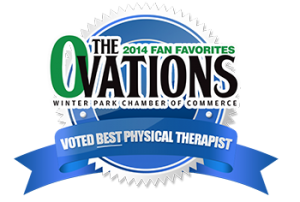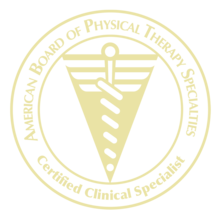Sitting with mid back pain at work, at a desk, or when watching TV is a very common symptom. It may be caused from poor posture, from a strained muscle, or it can be referred pain from the neck. People who sit for long periods of time, or individuals with arthritis in the cervical (neck) region can also be affected. Conservative care, including physical therapy, can help reduce symptoms. A physical therapist can help alleviate the acute neck and arm symptoms that result from the condition, as well as improve general strength and function. Most cases of cervical radiculopathy are resolved with physical therapy and do not require surgery.
What really is Mid Back Pain?
Cervical radiculopathy occurs when a nerve root coming off the spinal cord becomes compressed. The compression can occur for various reasons. In younger people, it may occur when a cervical disc herniates due to trauma. In older individuals, it commonly occurs spontaneously as a result of arthritis or decreased disc height in the neck region.
The cervical spine consists of 7 cervical vertebrae (the bones that form the neck region). Each vertebra is separated by a gel-like disc. The discs provide shock absorption for the spine. The spinal cord travels through a canal in the cervical vertebrae. Spinal nerve roots extend from the spinal cord and branch off going to specific locations in the arm. The spinal nerves send signals to our muscles for movement as well as sensations that we feel in the entire arm. The spinal cord is like a tree trunk, and the spinal nerves are like the tree branches. If an impingement or abnormal pressure is placed on a branch near the trunk, everything along that branch will be affected.
Spinal nerves can be impinged by:
- Arthritis or disc wear-and-tear with age
- Herniated or bulging discs from trauma or degeneration
- Spinal stenosis, which is a narrowing of the spaces in which the nerves travel
- Tumor, which can be benign or malignant, impinging the nerve root
When the spinal nerves are impinged, they cannot properly send messages to the muscles from the brain, nor receive proper sensation from the specific arm location the nerve travels. Everywhere the spinal nerve travels will be affected. That is why a pinched nerve in the neck can cause pain, weakness, and loss of sensation in the arm, even though the pinch is in the cervical region.
How Does Mid Back Pain feel?
Symptoms of cervical radiculopathy vary depending on the nerve root involved, and commonly occur on the same side of the body as the affected nerve. The symptoms may include:
- Pain in the neck, shoulder blade, shoulder, upper chest, or arm, with pain possibly radiating into the fingers following the path of the involved nerve root.
- Pain described as “sharp” or “pins-and-needles” or “popping sensation” in cervical or mid back region.
- General dull ache or numbness anywhere along the pathway of the nerve.
- Weakness in the shoulder, arm, or hand.
- Pain that worsens with certain neck movements.
- Pain that improves when the arm is lifted over and behind the head (relieving tension on the spinal nerve).
How Is Mid Back Pain Diagnosed?
When you seek the help of a physical therapist, the physical therapist performs a comprehensive evaluation and asks questions about your pain and your daily activities. These may include:
- How and when the pain started: Did the pain begin spontaneously or was there any trauma or popping experienced in the cervical region?
- Where are the symptoms located, and have they changed location or intensity since the onset?
- What makes the symptoms better or worse?
- What type of work do you perform?
- What hobbies or household activities do you regularly perform?
Your physical therapist will gently test the movement of your neck and arms. The therapist will check your tendon reflexes and strength, and conduct special tests on your neck and upper extremity to determine which spinal nerve root(s) may be involved, and to rule out other conditions. To provide a definitive diagnosis, your therapist may collaborate with an orthopedist or other health care provider. The orthopedist may order further tests, such as magnetic resonance imaging (MRI) or electromyography (EMG). An MRI can show soft tissues, including the spinal cord and nerve roots. This test can determine what is causing the compression on the nerves, including disc bulges or disc herniation. An EMG measures the nerve and muscle function. This test can tell how well your spinal nerves are communicating to your muscles.
How Can a Physical Therapist Help treat Mid Back Pain?
Physical therapy is an effective treatment for cervical radiculopathy, and in many cases, it completely resolves symptoms. Your physical therapist will develop an individual treatment plan based on the findings of your initial evaluation. The treatment plan may include:
Pain Management. The first goal is to reduce the pain and inflammation in the area. Ice packs applied to the neck and scapular (shoulder blade) region during the first 24 to 48 hours following the onset of pain, help reduce inflammation. Moist heat can be used after this time period to help the surrounding muscles relax. Your physical therapist may advise you to wear a soft cervical collar at times throughout the day, to allow the neck to relax. A cervical contoured pillow may be recommended to properly support the neck, and allow you to sleep more comfortably.
Manual Therapy. Your physical therapist may use manual therapy techniques, such as manual cervical traction, to relieve pressure in the cervical (neck) region. This procedure can provide immediate relief of pain and numbness radiating into the arm. Gentle massage may also be performed on the muscles of the cervical spine and scapular (shoulder blade) region. This technique helps the muscles relax and improves circulation to the area, promoting healing and pain relief.
Posture Education. Posture education is an important part of rehabilitation. Your physical therapist may suggest adjustments to your workstation and work habits, to promote good posture to protect your neck. In the early stages of recovery this may mean sitting only 15 to 20 minutes at a time. You will also receive instructions on how to bend, reach, and lift throughout the day in safe positions that place minimal pressure on your spinal discs.
Range-of-Motion Exercises. Your physical therapist will teach you gentle cervical mobility exercises to relieve your symptoms, and allow you to return to normal movement. In the beginning stages of recovery, it is important that none of these exercises increase the pain radiating down into your arm. It is important to communicate your symptoms accurately to your physical therapist. If you spend many hours sitting at a desk during your workday, your neck may become stiff. Your therapist will teach you neck stretches to take pressure off of your neck from extended periods of sitting, to help improve your mobility.
Strengthening Exercises. Your physical therapist will help you determine which muscle groups need to be strengthened based on which spinal nerves are involved in your particular case. When pain no longer radiates down your arm, you may begin more aggressive strengthening exercises. Neck stability (strengthening) exercises will also be performed. You will receive a home-exercise program to continue strengthening your neck, shoulder, arm, and upper back long after your formal physical therapy has ended.
Functional Training. As your symptoms improve, your physical therapist will work on functional exercises to help you return to your job, sport, or other daily activities. For example, if your job duties require overhead reaching, pushing, pulling, and long periods of sitting, you will be taught ways to perform these tasks to reduce undue stress to the neck.
Can a Mid Back Pain be Prevented?
Your physical therapist will educate you on the best ways to prevent cervical radiculopathy from recurring, including:
- Maintaining proper posture. Use a supportive pillow and proper posture when sitting at a desk or in the car.
- Setting up your workstation to minimize undue forces on the spine. You may be advised to use a hands-free phone, or adjust your computer monitor to avoid excessive twisting or extending of your neck in repetitive directions during the workday.
- Continuing with regular exercise to maintain spinal muscles flexibility and strength, including the upper body, middle back, and core muscles.
- Keeping a healthy weight to minimize unnecessary forces on the spine.
References:
http://www.moveforwardpt.com/SymptomsConditionsDetail.aspx?cid=805cbc55-0daa-4b08-b4be-225a7cebfb68#.VYGPvflViko





